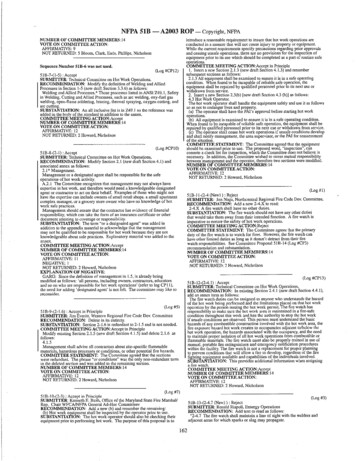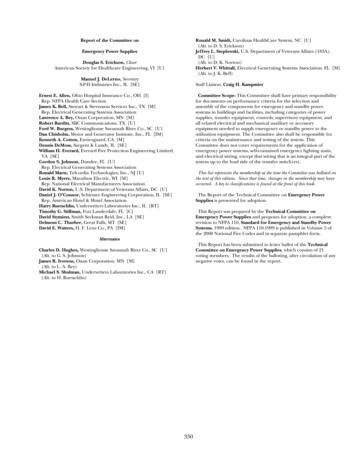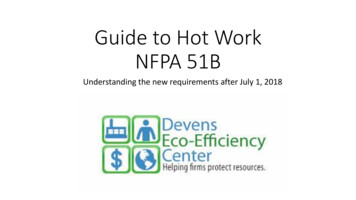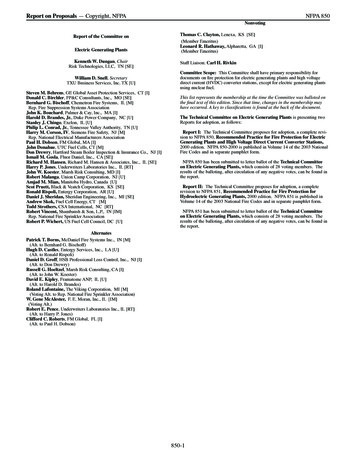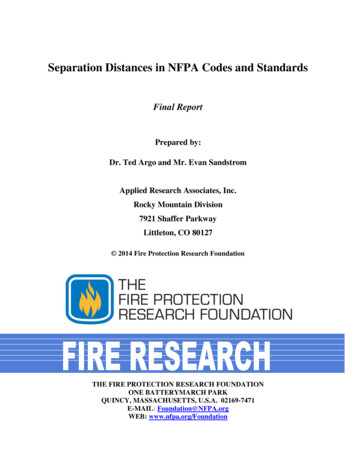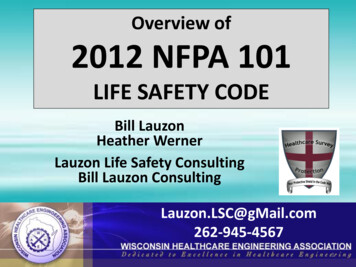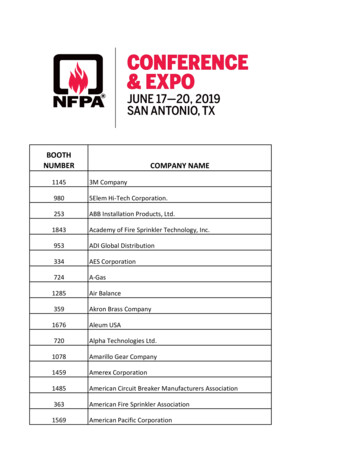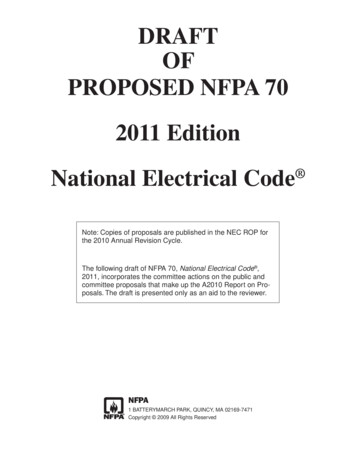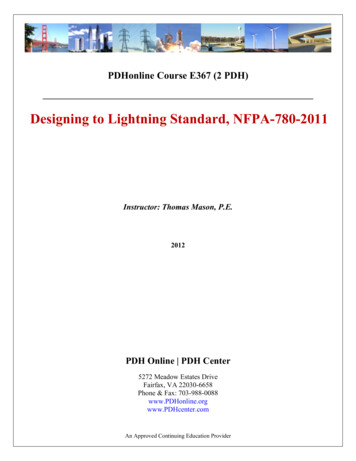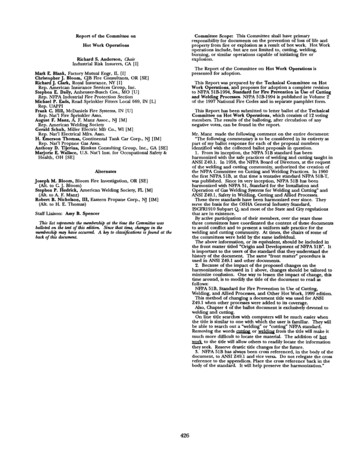
Transcription
Committee Scope: This Committee shall have primaryresponsibility for documents on the prevention of loss of life andproperty from fire or explosion as a result of hot work. Hot Workoperations include, but are not limited to, cutting, welding,burning, or similar operations capable of initiating fire orexplosion.Report of the Committee onHot Work OperationsRichard S. Anderson, ChairIndustrial Risk Insurers, CA [I]The Report of the Committee on Hot Work Operations ispresented for adoption.Mark E. Blank, Factory Mutual Engr, IL [I]Chrlstopher J. Bloom, CJB Fire Consultants, OR [SE]Richard J. Clark, Royal Insurance, NY [I]Rep. American Insurance Services Group, Inc.Stephen E. Daily, Anheuser-Busch Cos., MO [U]Rep. NFPA Industrial Fire Protection SectionMichael P. Eads, Road Sprinkler Fitters Local 669, IN [L]Rep. UAPPIFrank C. Hill, McDaniels Fire Systems, IN [U]Rep. Nat'l Fire Sprinkler Assn.August F. Manz, A. F. Manz Assoc., NJ [M]Rep. American Welding SocietyGerald Schuh, Miller Electric Mfr Co., Wl [M]Rep. Nat'l Electrical Mfrs. Assn.H. Emerson Thomas, Continental Tank Car Corp., NJ [IM]Rep. Nat'! Propane Gas Assn.Anthony D. Tijerina, Rimkus Consulting Group, Inc., GA [SE]Marjorie E. Wallace, U.S. Nat'l Inst. for Occupational Safety &Health, OH [SE]This Report was prepared by the Technical Committee on HotWork Operations, and proposes for adoption a complete revisionto NFPA 51B-1994, Standard for F'tre Prevention in Use of Cuttingand Welding Processes. NFPA 51B-1994 is published in Volume 2of the 1997 National Fire Codes and in separate pamphlet form.This Report has been submitted to letter ballot of the TechnicalCommittee on Hot Work Operations, which consists of 12 votingmembers. The results of the balloting, after circulation of anynegative votes, can be found in the report.Mr. Manz made the following comment on the entire document:"The following commentary is to be considered in its entirety aspart of my ballot response for each of the proposal numbersidentified with the collected ballot proposals in question.1. From its inception, the NFPA 51B standard has beenharmonized with the safe practices of welding and cutting taught inANSI Z49.1. In 1958, the NFPA Board of Directors, at the requestof the welding and cutting community, authorized the creation ofthe NFPA Committee on Cutting and Welding Practices. In 1960the first NFPA 51B, at that time a tentative standard NFPA 51B-T,was published. Since its very inception, NFPA 51B has beenharmonized with NFPA 51, Standard for the Installation andOperation of Gas Welding Systems for W e l d i n g a n d Cutting" andANSI Z49.1, Safety in Welding, Cutting and Allied Processes.These three standards have b e e n harmonized ever since. Theyserve the basis for the OSHA General Industry Standard,29CFR1910 Subpart Q, and most of the State and City regulationsthat are in existence.By active participation of their members, over the years thesethree committees have coordinated the content of these documentsto avoid conflict and to present a uniform safe practice for thewelding and cutting community. At times, the chairs of some ofthe committees were held by the same individual.The above information, or its equivalent, should be included inthe front matter tided "Origin and Development of NFPA 51B'. Itis important to the users of the standard that they understand thehistory of the document. The same Ufront matter" procedure isused in ANSI Z49.1 and other documents.2. Because of the impact of the proposed changes on theharmonization discussed in 1 above, changes should be tailored tominimize confusion. One way to lessen the impact of change, thistime around, is to modify the title of the document to read asfollows:NFPA 51B, Standard for Fire Prevention in Use of Cutting,Welding, and Allied Processes, and Other Hot Work, 1999 edition.This method of changing a document title was used for ANSIZ49.1 when other processes were added to its coverage.Also, Chapter 4 of the ballot document is exclusively devoted towelding and cutting.On line title searches with computers will be much easier whenthe fide is similar to one with which the user is familiar. They willbe able to search out a "welding" or "cutting" NFPA standard.Removing the words cutting or welding from the title will make itmuch more difficult to locate the material. The addition of hotwork to the title will allow others to readily locate the informationthey seek. Reserve drastic title changes for the future.3. NFPA 51B has always been cross referenced, in the body of thedocument, to ANSI Z49.1 and vice versa. Do not relegate the crossreference to the appendices. Place the cross reference back in thebody of the standard. It will help preserve the harmonization."AlternatesJoseph M. Bloom, Bloom Fire Investigation, OR [SE](Alt. to c J. Bloom)Stephen P. Hedrlck, American Welding Society, FL [M](Alt. to A. F. Manz)Robert B. Nicholson, II1, Eastern Propane Corp., NJ [IM](Alt. to H. E. Thomas)Staff Liaison: Amy B. SpencerThis list represents the membership at the time the Committee wasballoted on the text of this edition. Since that time, changes in themembership may have occurred. A key to classifications is found at theback of this document.426
NFPA 51B -- F98 ROP(Log #CP3)51B- 1 - (Foreword): AcceptSUBMITTER" Technical Committee on Hot Work OperationsRECOMMENDATION: Move Foreword to Appendix B and deleteor modify portions of the existing text to read as follows:Appendix B Significant Hotwork Incidents.Hotwork processes are a necessary part of our industrial world.Too often, however, the persons who use, hire, or supervise theuse of these processes do not fully appreciate that their improperuse can result in loss of life and property by fire and explosion. Infact, hotwork performed improperly is a major cause of fire.Appendix B is a collection of accounts of fires and explosionscaused by improper control of hotwork. Its sole purpose is toillustrate how such incidents occur and to emphasize therovisions of this standard.UBSTANTIATION: The existing Foreword is advisory in nature,and serves as an excellent introductory paragraph to the incidenceslisted in Appendix B.Much of the detail in the existing Foreword was removed becausethe information is already provided by examples or therequirements in the standard. In addition, the text was specific forwelding and cutting and did not take into account the expandedscope per Committee Proposal 5113-3 (Log #CP2).The text estimating that 6 percent of fires in industrial propertiesare caused by cutting and welding was thought by the Committeeto be a low estimate, therefore was also removed.COMMITTEE ACTION: Accept.N U M B E R OF COMMITTEE MEMBERS ELIGIBLE TO VOTE: 12VOTE ON COMMITTEE ACTION:AFFIRMATIVE: 12COMMENT ON AFFIRMATIVE:MANZ: Carefully edit and punctuate the roposed text. Forexample, you do not "hire" a process, you hire a contractor.among many others), refer to NFPA 51B as the document coveting"hotwork" operations, which goes beyond the current scope of thedocument or committee. NFPA 51B has become the de factostandard for all hotwork. Although the Committee consideredcreating an all new, separate document for hotwork, it seemed thatthis would be redundant; the requirements to perform weldingand cutting operations in a fire-safe manner are largely the same asthose requirements to perform hotwork in a safe manner. Inaddition, welding and cutting processes will be an integral part ofthe standard since welding a n d cutting processes are categorieswithin the term hotwork'.The current scope is too restrictive and does not specificallyinclude requirements for all the hotwork that is occurring andcausing fires and explosions, as documented in the NFPA report,"Special Data Information Package: Torches" prepared by theNFPA Fire Analysis Department (Jan. 1997). Processes excludedin the current scope are, among others, soldering, torch appliedroofing, grinding, flame removal of paint, and thawing of pipes.Additional requirements for confined spaces and lockout/tagoutare covered by other standards, and it is beyond the scope of thisdocument.COMMITTEE ACTION: Accept.NUMBER OF COMMITIT.E MEMBERS ELIGIBLE T O VOTE: 12VOTE ON COMMITTEE ACTION:AFFIRMATIVE: 11NEGATIVE: 1EXPLANATION OF NEGATIVE:MANZ: The location of the hot work is unimportant. Therefore,in 1-2.1.1 delete "in institutional.operations." For example, youdid not include farm and dairy operations. Make the text reflectgeneral use by removing reference to spedfic use.In 1-2.1.2 delete "performed in a non-designated area ". The safepractice of welding and cutting (as well as other hot work) mustbe considered in all areas. Even designated areas can havehazards, as for example the assembly of panels constructed withflammable insulation. (Log #CP4)51B- 2 - (1-1): AcceptSUBMITFER: Technical Committee on Hot Work Operations[ RECOMMENDATION: 1-1 Purpose. This standard has beenI prepared for the guidance of persons who manage, supervise andI perform hotwork, including outside contractors and propertyI managers where hotwork is performed.SUBSTANTIATION: The wording was changed to incorporatehotwork in the new proposed scope [See Committee Proposal51B-3 (Log #CP2).] The wording was made more user-frlendly.The firewatcher was removed to simplify the text.COMMITTEE ACTION: Accept.NUMBER OF COMMrFFEE MEMBERS ELIGIBLE TO VOTE: 12VOTE ON COMMITTEE ACTION:AFFIRMATIVE: 12COMMENT ON AFFIRMATIVE:MAN-Z: Firewatchers are a very important to the safe practice ofhot work. They do not manage, supervise or perform hot work.They should be added back into the text. The benefit of includingthem outweighs the motive of text simplification.(Log #CPt)51B- 4 - (1-3 (New)): AcceptSUBMITTER: Technical Committee on Hot Work Operations] RECOMMENDATION: Add a new section 1-3 to read as follows:I 1-3 Equivalency. Nothing in this standard is intended to preventI the use of systems, methods of, or devices of equivalent or superior] quality, strength, fire resistance, effectiveness, durability, and safetyI over those prescribed by this standard, provided technicalI documentation is submitted to the authority having jurisdiction toI demonstrate equivalency and the system, method, or device is[ approved for the intended purpose.SUBSTANTIATION: Added to comply with the NFPACommittee Officers' Guide.COMMITTEE ACTION: Accept.N U M B E R OF COMMITTEE MEMBERS ELIGIBLE T O VOTE: 12VOTE ON COMMITTEE ACTION:AFFIRMATIVE: 12(Log #CP2)51B- - (1-2 Scope): AcceptSUBMITTER: Technical Committee on Hot Work OperationsRECOMMENDATION: Change document scope, 1-2 to read asfollows:1-2 Scope.1-2.1 General.1-2.1.1 This standard covers provisions to preventloss of life and property from fire or explosion as a result ofhotwork in institutional, commercial and industrial operations.1-2.1.2 This standard covers the following processes performed ina non-designated aremI welding and allied processes; heat treating; grinding; thawing pipe,I torch-applied roofing; powder driven fasteners; hot rivets; drilling;I or similar applications producing a spark or flame.[ 1-2.1.3 This standard does not cover the following:[ candles; pyrotechnics or special effects; cooking operations; design[ and installation of gas cutting and welding equipment covered inI NFPA 51; additional requirements for hot work operations in[ confined spaces; or lockout/tagout procedures during hotwork.SUBSTANTIATION: NFPA 51B is currently being used byindustry and authorities having jurisdiction for hotwork beyond gasand electric cutting and welding. In fact, other NFPA documents(including NFPA 61, 11-2.1; NFPA 241, 9-5.1; NFPA 307, 9-11.2(Log #CP7)51B- 5 - (1-4 (New)): AcceptSUBMrrTER: Technical Committee on Hot Work OperationsRECOMMENDATION: Add a section 1-4 to read as follows:I-4 Retroactivitv. The nrovisions of this document areconsidere necessary to t rovide a reasonable level of nrotectionfrom loss of life a n d t)ronertv from fire and exnlosion.- Theyreflect situations and'thestate-of-the-art nrevalent at the time theUnless otherwise noted, it is not intended that the nrovisions ofthis document be annlied to facilities, eouiDment, structures, orinstallations that were existin or annroved'for construction orinstallatioll prior to the effective da'te of the dootment, excent inthose cases where it is determined bv the authority havingJurisdiction that the existing situation involves a distinct hazard tolife or adiacent nronertv, vSUBSTA]qTIA'IcIOIq: 'he statement was added to reflectguidanceprovided in Appendix 13-7 in the NFPA CommitteeOfficers Guide.COMMITTEE ACTION: Accept.427
NFPA 51B -- F98 ROP(Log #CPS)51B- 7 - (Chapter 2, Title): AcceptSUBMI'Iq'ER: Technical Committee on Hot Work Operations[ RECOMMENDATION: Change Chapter 2 title to read:I Chapter 2 Responsibility for Hotwork.SUBSTANTIATION: The hotwork was added to reflect theexpanded scope proposed in Committee Proposal 51B-3 (Log#CP2).COMMITTEE ACTION: Accept.NUMBER OF COMMITTEE MEMBERS ELIGIBLE TO VOTE: 12VOTE ON COMMITTEE ACTION:AFFIRMATIVE: 12NUMBER OF COMMITTEE MEMBERS ELIGIBLE TO VOTE: 12VOTE ON COMMITTEE ACTION:AFFIRMATIVE: 12(Log #CPS)51B- 6 - (1-5 Allied Processes, Approved, Authority HavingJurisdiction, Designated Area, Hotwork, Management, Permit,Permit Authorizing Individual (PAl) (New)): AcceptSUBMITTER: Technical Committee on Hot Work Operations[ RECOMMENDATION: Add a Definitions section, 1-5, and it shallI read as follows:[ 1-5 Definitions.] Allied Processes. Those processes such as, thermal spraying,oxygen cutting, arc cutting, electron beam cutting and laser beamI cutting.I Approved.* Acceptable to the authority having jurisdiction.] Authority Having Jurisdiction.* The organization, office, orindividual responsible for approving equipment, an installation, ora procedure.Designated Area. Permanent location designed or approved forhotwork operations to be performed regularly.Hotwork. Any work involving burning, welding or similaroperations capable of initiating fires
NFPA 51B, Standard for Fire Prevention in Use of Cutting, Welding, and Allied Processes, and Other Hot Work, 1999 edition. This method of changing a document title was used for ANSI Z49.1 when other processes were added to its coverage. Also, Chapter 4 of the ballot document is exclusively devoted to welding and cutting. On line title searches with computers will be much easier when the fide .
